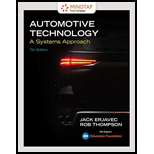
Mindtap For Erjavec/thompson's Automotive Technology: A Systems Approach, 4 Terms Printed Access Card (mindtap Course List)
7th Edition
ISBN: 9781337794381
Author: Jack Erjavec, Rob Thompson
Publisher: Cengage Learning
expand_more
expand_more
format_list_bulleted
Concept explainers
Textbook Question
Chapter 6, Problem 8MC
When conducting an oil pressure test: Technician A says that lower than normal pressure can be caused by faulty piston oil rings. Technician B says that lower than normal oil pressure can be caused by excessive engine bearing clearances. Who is correct?
- Technician A
Expert Solution & Answer
Want to see the full answer?
Check out a sample textbook solution
Students have asked these similar questions
PROBLEM 3.23
3.23 Under normal operating condi-
tions a motor exerts a torque of
magnitude TF at F. The shafts
are made of a steel for which
the allowable shearing stress is
82 MPa and have diameters of
dCDE=24 mm and dFGH = 20
mm. Knowing that rp = 165
mm and rg114 mm, deter-
mine the largest torque TF
which may be exerted at F.
TF
F
rG-
rp
B
CH
TE
E
1. (16%) (a) If a ductile material fails under pure torsion, please explain the failure
mode and describe the observed plane of failure.
(b) Suppose a prismatic beam is subjected to equal and opposite couples as shown
in Fig. 1. Please sketch the deformation and the stress distribution of the cross
section.
M
M
Fig. 1
(c) Describe the definition of the neutral axis.
(d) Describe the definition of the modular ratio.
using the theorem of three moments, find all the moments, I only need concise calculations with minimal explanations. The correct answers are provided at the bottom
Chapter 6 Solutions
Mindtap For Erjavec/thompson's Automotive Technology: A Systems Approach, 4 Terms Printed Access Card (mindtap Course List)
Ch. 6 - Explain why testlights are not recommended for...Ch. 6 - Name the two basic types of compression gauges.Ch. 6 - What tool is used to test engine manifold vacuum.Ch. 6 - Describe two methods of trapping asbestos/brake...Ch. 6 - True or False? A compression gauge will show the...Ch. 6 - True or False? A lab scope is a visual voltmeter...Ch. 6 - True or False? A brake shoe adjusting gauge is an...Ch. 6 - Prob. 1MCCh. 6 - Technician A says that a brake drum micrometer has...Ch. 6 - Technician A says that a pyrometer measures...
Ch. 6 - Prob. 4MCCh. 6 - Technician A uses a digital volt/ohmmeter to test...Ch. 6 - Technician A says that a charging station removes...Ch. 6 - Which of the following statements about manifold...Ch. 6 - When conducting an oil pressure test: Technician A...Ch. 6 - Which of the following conditions can be revealed...Ch. 6 - Technician A uses a high-impedance testlight on...Ch. 6 - Technician A says that a sulfated and plugged fuel...Ch. 6 - The tests conducted by a scan tool can also be...Ch. 6 - When using a fuel injector pulse tester....Ch. 6 - To measure engine cranking current, a DNIM...Ch. 6 - While discussing a clutch alignment tool....Ch. 6 - Technician A says that ball joints may be pressed...Ch. 6 - Which of the following is not a suitable way to...Ch. 6 - Prob. 18MC
Knowledge Booster
Learn more about
Need a deep-dive on the concept behind this application? Look no further. Learn more about this topic, mechanical-engineering and related others by exploring similar questions and additional content below.Similar questions
- PROBLEM 3.46 The solid cylindrical rod BC of length L = 600 mm is attached to the rigid lever AB of length a = 380 mm and to the support at C. When a 500 N force P is applied at A, design specifications require that the displacement of A not exceed 25 mm when a 500 N force P is applied at A For the material indicated determine the required diameter of the rod. Aluminium: Tall = 65 MPa, G = 27 GPa. Aarrow_forwardFind the equivalent mass of the rocker arm assembly with respect to the x coordinate. k₁ mi m2 k₁arrow_forward2. Figure below shows a U-tube manometer open at both ends and containing a column of liquid mercury of length l and specific weight y. Considering a small displacement x of the manometer meniscus from its equilibrium position (or datum), determine the equivalent spring constant associated with the restoring force. Datum Area, Aarrow_forward
- 1. The consequences of a head-on collision of two automobiles can be studied by considering the impact of the automobile on a barrier, as shown in figure below. Construct a mathematical model (i.e., draw the diagram) by considering the masses of the automobile body, engine, transmission, and suspension and the elasticity of the bumpers, radiator, sheet metal body, driveline, and engine mounts.arrow_forward3.) 15.40 – Collar B moves up at constant velocity vB = 1.5 m/s. Rod AB has length = 1.2 m. The incline is at angle = 25°. Compute an expression for the angular velocity of rod AB, ė and the velocity of end A of the rod (✓✓) as a function of v₂,1,0,0. Then compute numerical answers for ȧ & y_ with 0 = 50°.arrow_forward2.) 15.12 The assembly shown consists of the straight rod ABC which passes through and is welded to the grectangular plate DEFH. The assembly rotates about the axis AC with a constant angular velocity of 9 rad/s. Knowing that the motion when viewed from C is counterclockwise, determine the velocity and acceleration of corner F.arrow_forward
arrow_back_ios
SEE MORE QUESTIONS
arrow_forward_ios
Recommended textbooks for you
 Automotive Technology: A Systems Approach (MindTa...Mechanical EngineeringISBN:9781133612315Author:Jack Erjavec, Rob ThompsonPublisher:Cengage Learning
Automotive Technology: A Systems Approach (MindTa...Mechanical EngineeringISBN:9781133612315Author:Jack Erjavec, Rob ThompsonPublisher:Cengage Learning Automotive TechnologyMechanical EngineeringISBN:9781337794213Author:ERJAVEC, Jack.Publisher:Cengage,
Automotive TechnologyMechanical EngineeringISBN:9781337794213Author:ERJAVEC, Jack.Publisher:Cengage, Refrigeration and Air Conditioning Technology (Mi...Mechanical EngineeringISBN:9781305578296Author:John Tomczyk, Eugene Silberstein, Bill Whitman, Bill JohnsonPublisher:Cengage Learning
Refrigeration and Air Conditioning Technology (Mi...Mechanical EngineeringISBN:9781305578296Author:John Tomczyk, Eugene Silberstein, Bill Whitman, Bill JohnsonPublisher:Cengage Learning

Automotive Technology: A Systems Approach (MindTa...
Mechanical Engineering
ISBN:9781133612315
Author:Jack Erjavec, Rob Thompson
Publisher:Cengage Learning

Automotive Technology
Mechanical Engineering
ISBN:9781337794213
Author:ERJAVEC, Jack.
Publisher:Cengage,

Refrigeration and Air Conditioning Technology (Mi...
Mechanical Engineering
ISBN:9781305578296
Author:John Tomczyk, Eugene Silberstein, Bill Whitman, Bill Johnson
Publisher:Cengage Learning
Properties of Fluids: The Basics; Author: Swanson Flo;https://www.youtube.com/watch?v=TgD3nEO1iCA;License: Standard YouTube License, CC-BY
Fluid Mechanics-Lecture-1_Introduction & Basic Concepts; Author: OOkul - UPSC & SSC Exams;https://www.youtube.com/watch?v=6bZodDnmE0o;License: Standard Youtube License